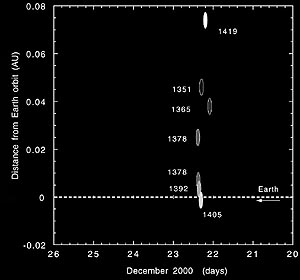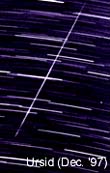|
Leonid MAC |
| home |
| View the shower |
| Mission Brief |
| Science Update |
| Media Brief |
| links |
LEONID DAILY NEWS: December 18, 2000

Figure showing where various dust particles ejected by comet Tuttle will
cross the ecliptic plane six centuries later in the years 1994-2003.
PREDICTIONS FOR UPCOMING DEC. 22 URSID OUTBURST: ANOTHER LEONID-TYPE SHOWER!
Meteoroids ejected in 1405, before the birth of Columbus, are destined to hit
Earth on December 22, 2000, at around 7:29 UT. The event is best seen from the
USA and Canada. The shower will be 3-4 hours wide and have a
peak rate of perhaps 1 per minute under good observing conditions,
but many of these meteors may be faint. The peak time corresponds to 02:29 UT
Eastern Standard Time (Dec. 22), 00:29 Mountain Time (Dec. 22)
or 23:29 Pacific Standard Time (Dec. 21).
Meteor astronomer Peter Jenniskens of the SETI Institute, at NASA Ames Research Center,
and his colleague Esko Lyytinen of Helsinki, Finland, applied the same tools used to predict the
recent Leonid showers to another Halley-type comet, 8P/Tuttle, the source
of the Ursids. They discovered why intense outbursts in 1945 and 1986 occurred
six year's after passage of the comet. Moreover, they predict
another outburst on December 21, 2000, when Earth will cross a dense trail of dust
ejected during the comet's return in 1405. To alert meteor observers, a
paper has been submitted to WGN, the Journal of the International Meteor Organisation.
Graph showing the location of the Tuttle dust trails from ejecta from different
returns of the comet as they are near Earth's orbit in the year 2000. Figure below shows
an example Ursid meteor.
The explanation is in the fact that the particles are trapped in orbital resonances that
determine the dynamical evolution of the shower. The meteoroids are released in an
orbit that is completely outside of Earth's orbit. Once trapped, it takes 6 centuries
for the meteoroid orbits to be perturbed enough to encounter the Earth. The particles
are in a slightly wider orbit than the comet. The particle's orbital period is a factor of
7/6 times that of Jupiter. The comet's orbital period (13.62 years)
is a factor 15/13 times that of
Jupiter. The difference adds up to 600 x (7/6 divided by 15/13) - 600 = 6.7
years after 6 centuries. This explains why the dust arrives at the Earth about 6
years after the comet.
From many years of observations,
Jenniskens discovered that the Ursid shower has two types of outbursts:
broad outburst near perihelion and narrow outbursts near aphelion. The broad outbursts from
what is now called the Ursid Filament,
turn out to have a rather dispersed radiant and can not be from a single dust trail. The aphelion
outbursts, however, are narrow and may well originate from a single dust trail.
Lyytinen calculated the position of the dust trails of comet 8P/Tuttle as created
during each return 6 centuries ago,
using the same approach as for earlier predictions of the Leonid shower. The trailet of
1378 was identified
as the cause of the 1986 Ursid outburst, and that of 1392 as the cause of the 1945
outburst.
Now, in December 2000, the comet is again at aphelion. The figure to the right shows
the position of the dust trailets during this year's encounter. The
dust trailet of 1405 will be in the Earth's path. A meteor outburst is expected around
7:29 UT. The shower will be 3-4 hours wide. Rates may go up to 1 per minute under
good observing conditions, but many of those will be fairly faint. Observers are recommended
to go to a dark and clear-sky location. The Moon will not be disturbing.
The shower will not be as intense as recent Leonid outbursts, but may
prove an important event to test some of physical processes
observed for the Leonids. The meteoroids can be dated precisely and have the
same dynamical background as the Leonids. However, they originate from a
diffrerent comet, have spend six times longer
in space before hitting Earth and come in at only half the velocity
(Full paper (pdf); Full paper (HTML version) ).
Dec. 18 - Dec 22 Ursid outburst Nov. 20 - A bacterial fingerprint? Nov. 15 - HCN disappears mysteriously Nov. 14 - Meteor shower from space Nov. 13 - Organic fingerprint Nov. 12 - Train airglow chemistry Nov. 11 - Hard bits and persisting glows Nov. 10 - Meteoroid debris detected Nov. 09 - New meteor picture Nov. 08 - Spin city Nov. 07 - Meteors affect atmospheric chemistry Nov. 06 - Listen to this! Nov. 04 - Fear of heights? Nov. 03 - The pale (infra-red) dot Nov. 02 - Twin showers Nov. 01 - Leonids approaching Earth Oct. 31 - Prospects for Moon Impact Studies Oct. 30 - Comet dust crumbled less fine Today's news
| ||



